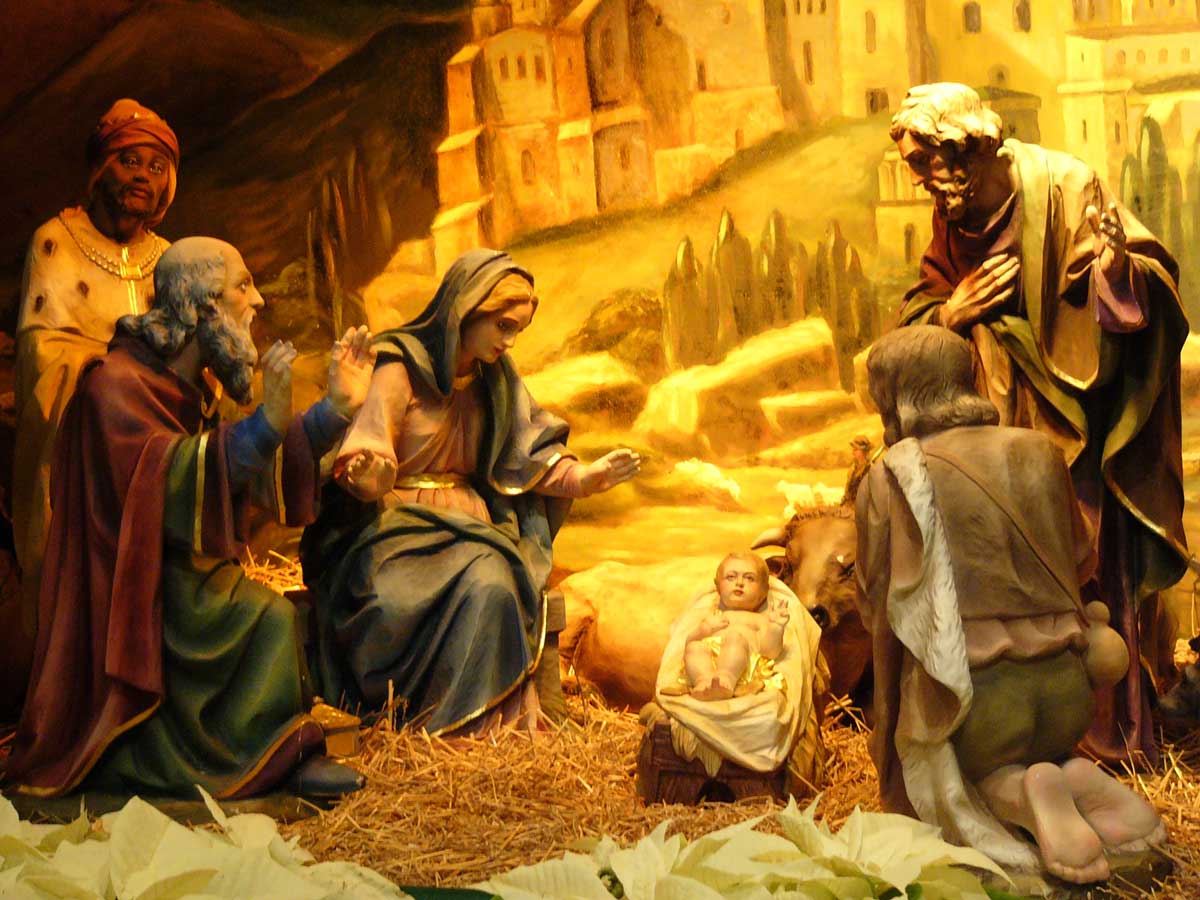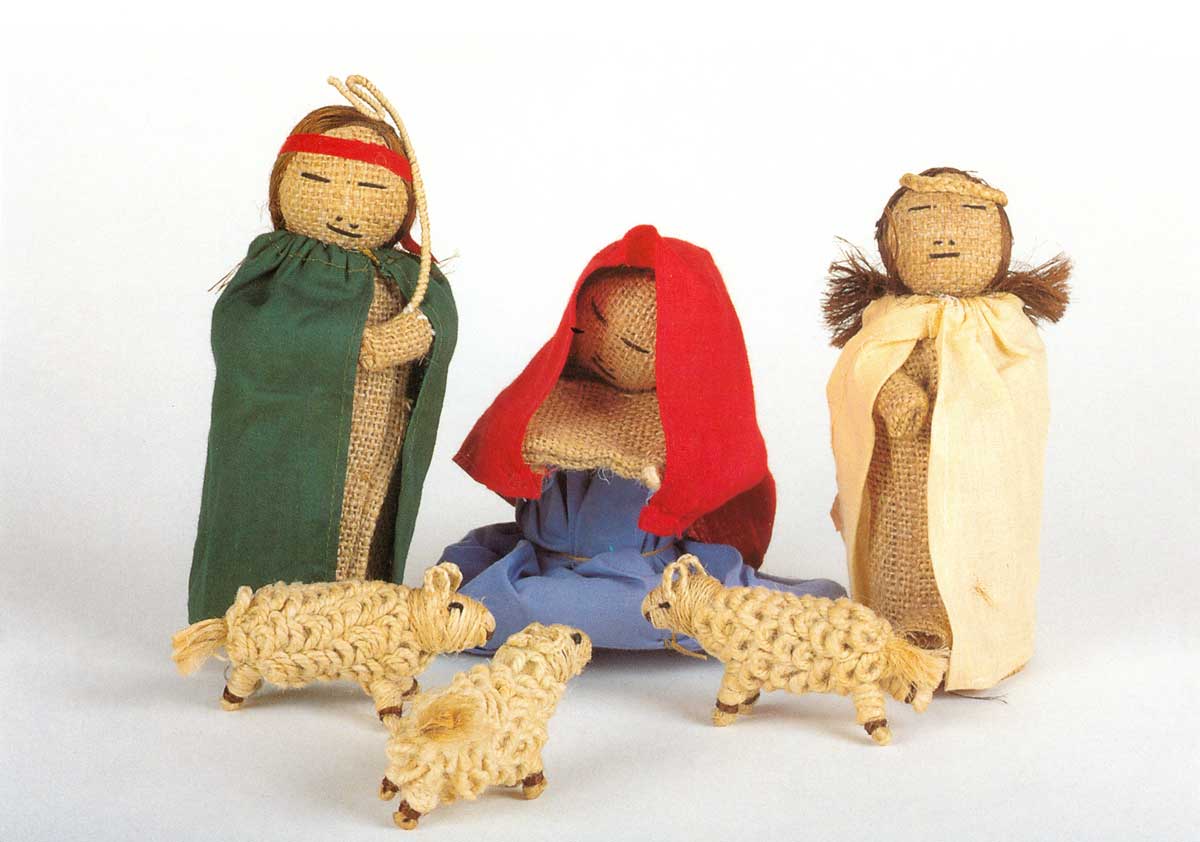Away in a Manger: Nativity sets of the world
December 2024
SMACK DAB IN THE MIDDLE
Away in a Manger: Nativity sets of the world
by Donald-Brian Johnson
“And she brought forth her first-born son,
and wrapped him in swaddling clothes,
and laid him in a manger…”
In Germany, it’s called a Weihnachtskrippe. Spaniards know it as a naciamento. Italians say presepio; for the French, it’s a crèche. Since that starry night in Bethlehem 2,000 years ago, the celebration of Christmas has almost always included some scenic tribute to the Nativity. From simple representations of the three principal figures — the Holy Family of Jesus, Mary, and Joseph — Nativity sets have grown to include figurines of almost everyone even remotely connected to the Christmas story. In addition to the expected—angels, shepherds, the Three Kings, and a varied assortment of friendly beasts—many modern manger scenes also incorporate mythic secular characters. Current Bethlehem visitors include little drummer boys, homeless kittens — even kneeling Santas.
Early pilgrimages to the Holy Land served as inspiration for the Nativity scene tradition, and a sixth-century Roman basilica, “Holy Mary of the Nativity,” featured the first three-dimensional figures. It was, however, several more centuries before the concept of a figural Nativity scene really took hold. In the meantime, there were the “living Nativities” of the Middle Ages, staged in churches by costumed performers. The earliest and most famous of these was created by St. Francis of Assisi in 1223.
St. Francis felt that, for many of his congregation, Christmas had lost its true meaning. A “living Nativity” would bring the story closer to them. The village of Greccio, near Assisi, was restyled as Bethlehem; local shepherds (and their livestock) starred as the main characters. On Christmas Eve, torch-bearing villagers arrived to experience, in person, the wonder of the crèche.
Nativity dramas became a much-anticipated annual social event, but the boisterous crowds eventually proved too much for somber cathedrals. By the late 16th century, Nativity re-enactments had moved to town squares, eventually disappearing from view. The tradition resurfaced in the 20th century, with many communities again staging “living Nativities.” One of the most spectacular has been featured at New York’s Radio City Music Hall.
Figural representations were popularized in the 15th and 16th centuries by the Jesuits. These Nativity scenes in European churches were fashioned of wood, terra cotta, stone, fabric, or metal. They could be nearly full-size, half-size, or miniature, depending on space, and were often backed by a realistic stable setting.

Detail of a traditional Nativity scene, St. Mary Magdalene’s Catholic Church, Omaha, NE. (Image courtesy of the author)

A Bangaladeshi Nativity rendition, of natural jute and hand-woven cloth. Six pieces, including angel and playful sheep. Tallest figure, 6-1/2”. $20-25. (Image courtesy of Leslie Piña)
By the early 17th century, these displays were also found in homes, a custom that had its roots in southern Italy. In some European countries, devout families even kept a manger scene on display year-round. Early home crèches were handcrafted, a time-consuming and costly process. The scenes became increasingly more elaborate, with the humble inhabitants of Bethlehem’s stable decked out in fine linens and brocades, and the crowns of the Wise Men dotted with precious jewels.
Those who could not afford such splendor often crafted manger scenes from whatever materials were at hand. As Christianity spread, this form of self-expression flourished. The influence of individual cultures can be seen to wonderful advantage in Nativity sets from around the world. Each interpretation incorporates indigenous materials and envisions the principal Nativity characters with a sensibility inherent to the locale. A Zulu rendition of the Holy Family, fashioned from fabric, beads, wood, and straw, may seem to have little correlation to a Renaissance religious painting. There is, however, a strong bond between the two: the universality of the Christmas story.
Today, manger scenes continue to be reimagined in countless ways. For many, however, the “real” Nativity set will always be the one that has been handed down from generation to generation. The plaster may be chipped on this piece, the paint a bit faded on that one. A donkey may be missing a foot; there may be a Bethlehem Star that stubbornly refuses to light. But still, these visual reminders of the Christmas story continue to inspire, some 2,000 years on.
Merry Christmas!
Say it with music: Collecting Broadway musical cast albums
June 2024SMACK DAB IN THE MIDDLE Say it with music: Collecting Broadway musical cast albumsby Donald-Brian Johnson “People Will Say We’re In Love”. . . “76 Trombones”. . . “Tomorrow”. . . “The Impossible Dream”. . . “I Could Have Danced All Night”. . . You may never...
Five of a kind: The Dionne Quintuplets
May 2024SMACK DAB IN THE MIDDLE Five of a kind: The Dionne Quintupletsby Donald-Brian Johnson In the 1930s, Shirley Temple was America’s sweetheart.Ah, but there was only one Shirley. There were five Dionnes. Ninety years ago, on May 28, 1934, the Dionne sisters, the...
Planting time: Fascinating figural planters
April 2024SMACK DAB IN THE MIDDLE Planting time: Fascinating figural plantersby Donald-Brian Johnson Spring is here at last! Time to break out the spades, and break in those new gardening gloves. Time to ferret out that trowel from wherever you stashed it last fall....
Hoppin’ down the bunny trail: America’s Easter traditions
March 2024 SMACK DAB IN THE MIDDLE Hoppin’ down the bunny trail: America’s Easter traditions by Donald-Brian Johnson “Here Comes Peter Cottontail, Hoppin’ down the bunny trail, Hippity, hoppity, Easter’s on its way!” (Steve Nelson & Jack Rollins, 1950) That Gene...
Valentine boxes evoke childhood memories
February 2024SMACK DAB IN THE MIDDLEValentine boxes evoke childhood memoriesby Donald-Brian JohnsonHere’s a memory-jogger: it’s Valentine’s Day in mid-20th century America, and across the country, nearly every elementary school classroom has something in common. Atop...
This month: ‘Just an old Christmas card’
December 2023SMACK DAB IN THE MIDDLEThis month: 'Just an old Christmas card'by Donald-Brian JohnsonHere’s when the Christmas season really gets underway: one wintry day, amongst the deluge of bills and ads, your daily mail coughs up something out of the ordinary....

